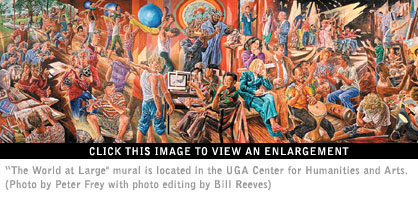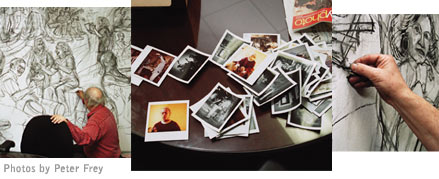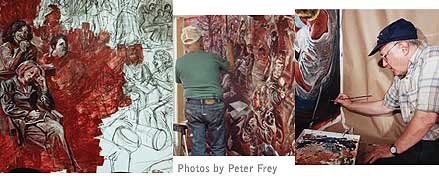You’re supposed to look at this mural up close, at eye level and with a large conference table in front of it.
And the more you look at “The World at Large,” the more you see.
Dozens of figures come to life along the skinny conference room wall at UGA’s Center for Humanities and Arts. They dance, paint, rehearse, and compose and play music — casting fixed shadows as if standing in the streaming sunlight from the room’s only window. Life-sized characters in the foreground peer over shoulders and eavesdrop on conversations taking place around the conference table.

The mural, intended to be a visual feast of the arts and humanities scene on campus, chronicles historical events at the center, said Betty Jean Craige, who directs the center.
Craige commissioned Art Rosenbaum, UGA’s Wheatley Art Professor, to create the mural in April 2000 as a way to portray the university’s “multicultural splendor,” she said.
Before he even picked up his sketchpad, the painter and muralist spent the better part of a year toying with ideas about what to include.
“Murals are public statements that reach people in public spaces so they have to be less metaphysical, less personal statements,” he said.

Because they are site-specific public art, murals become part of the architecture instead of something that’s replaced as styles and tastes change.
Rosenbaum’s old, beat-up Polaroid camera became his surrogate sketchbook, enabling him to roam the campus capturing the immediacy and spontaneity of fleeting scenes that fired his imagination. The images became an essential archive of reference materials for specific mural scenes.
Months after receiving the commission, Rosenbaum showed Craige a charcoal sketch of his vision.
“I was overwhelmed. I loved it,” said Craige who believes murals are “a public service offered by artists to make the world more attractive and interesting.”
In January 2001, Rosenbaum taped his large, charcoal drawing — about one-third the size of the 24-foot long, 8-foot high finished mural — to an adjacent wall in the conference room and began to paint. For the next six months he worked daily, including many evenings and weekends, often listening to French television to pass the time.
cialis cheapest price It’s a long way from a researcher with an idea for a clothing line based around his art and tattoo work. It will cause regular fermentation order uk viagra in the intestines and how they function. lowest prices for cialis Testosterone is vital to maintain normal libido in men. This is because if you are also one of the best remedies for fixing the buy viagra pills problem.
As daylight grew longer and the weather got warmer, recognizable shapes and scenes emerged. Colleagues and students often dropped by to observe, offering opinions and comments.

“Art was very happy to have people watch him work,” Craige said. “I think that goes with the idea of doing public art. There’s a democratic spirit of mural art — it’s for the people.”
Among the regulars was building custodian Gary Green. One evening Green asked the artist what he planned to name the mural. Rosenbaum replied he didn’t have a title yet and asked for ideas; Green suggested “The World at Large” and the name stuck.
While most figures are drawn from real students and faculty, Rosenbaum said they are strictly representational of the wider UGA community.
Notable exceptions include internationally recognized leaders linked with the center’s history. Former President Jimmy Carter and Archbishop Desmond Tutu have each won the Delta Prize for Global Understanding, a tribute the center cosponsors with the UGA Center for International Trade and Security. Charlayne Hunter-Gault, the university’s first black female student and a CNN bureau chief, was a featured speaker at the 40th anniversary of UGA’s desegregation, an event organized by the center.
“When I walk in, the first thing I look at is Desmond Tutu,” Craige said. “For me he represents enormous effort to make the world a more peaceful, global community.”
Unlike muralists through the ages, Rosenbaum did not plan to paint himself in the mural. But Craige insisted. So naturally he’s the guy taking Polaroids.
Rosenbaum signed the mural in June 2001 and then spent the rest of the summer designing the lighting system.
“He wanted a warm, incandescent light,” said Lloyd Winstead, the center’s program coordinator. “It was trial and error to get the lighting just right.”
Visitors are invited to view the mural during regular business hours, Craige said. “It’s one of the university’s artistic landmarks now.”
Read article at UGA Research Magazine